Unit 7 Seasons Period 3课件(共31张PPT)牛津译林版八年级上册
文档属性
| 名称 | Unit 7 Seasons Period 3课件(共31张PPT)牛津译林版八年级上册 | 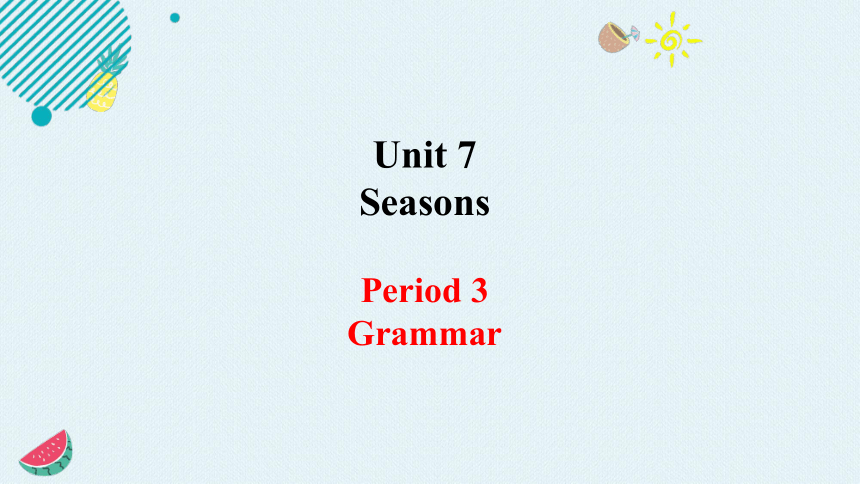 | |
| 格式 | pptx | ||
| 文件大小 | 736.8KB | ||
| 资源类型 | 教案 | ||
| 版本资源 | 牛津译林版 | ||
| 科目 | 英语 | ||
| 更新时间 | 2024-08-06 00:18:08 | ||
图片预览

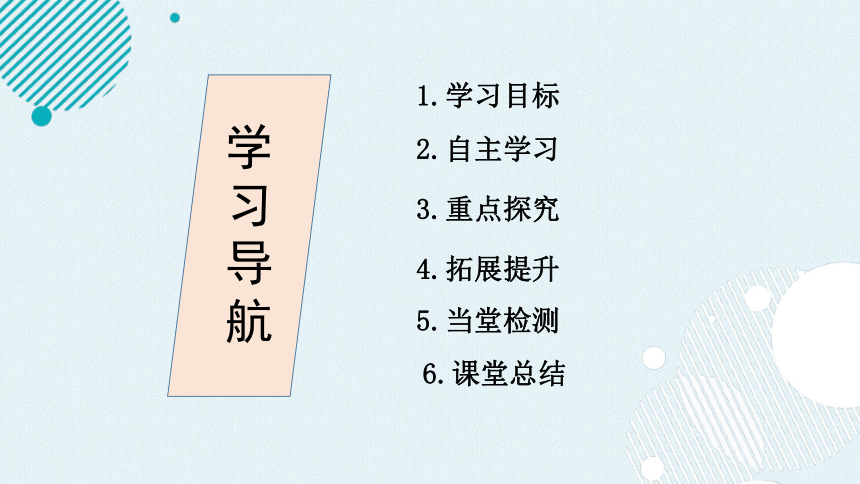
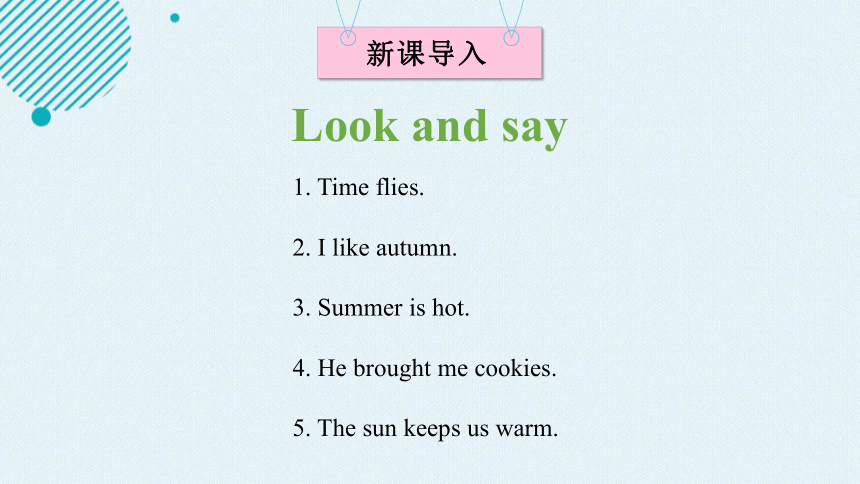
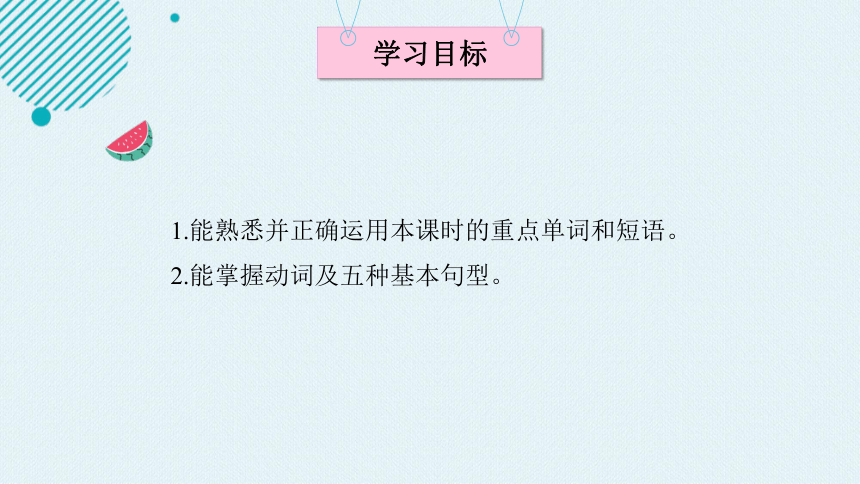
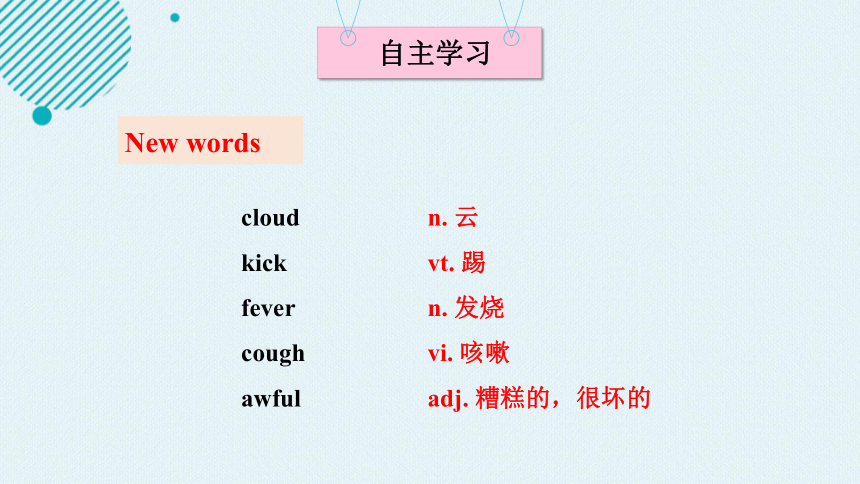
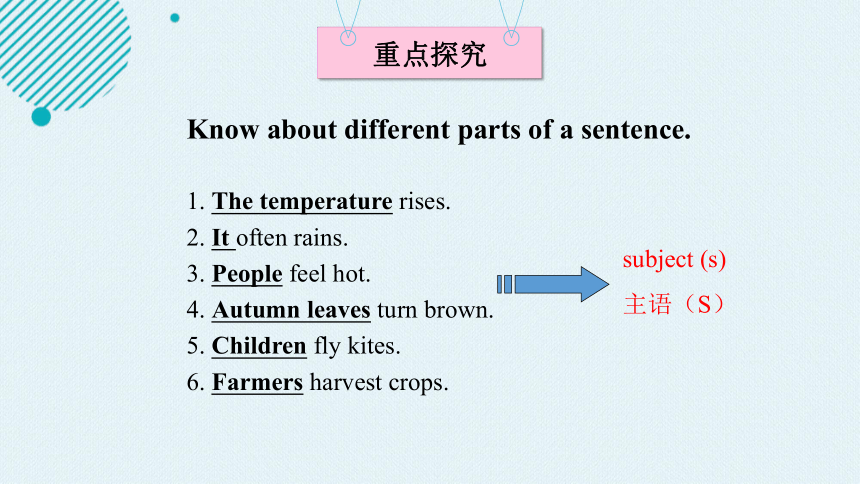
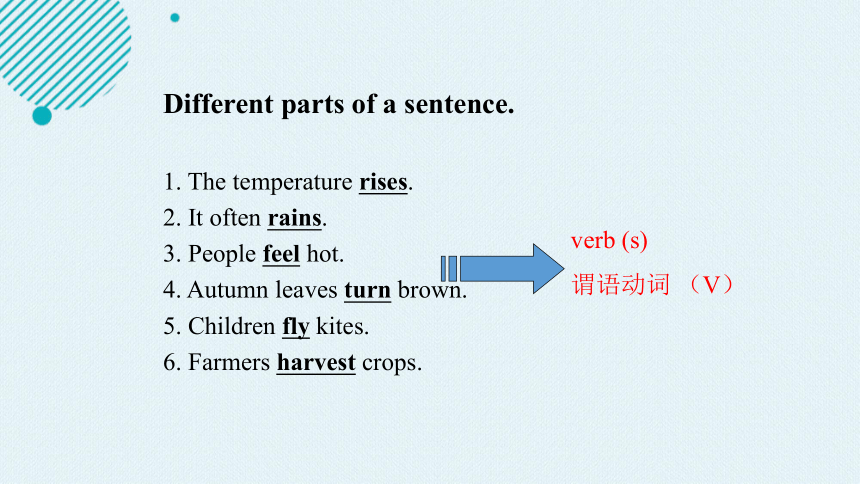
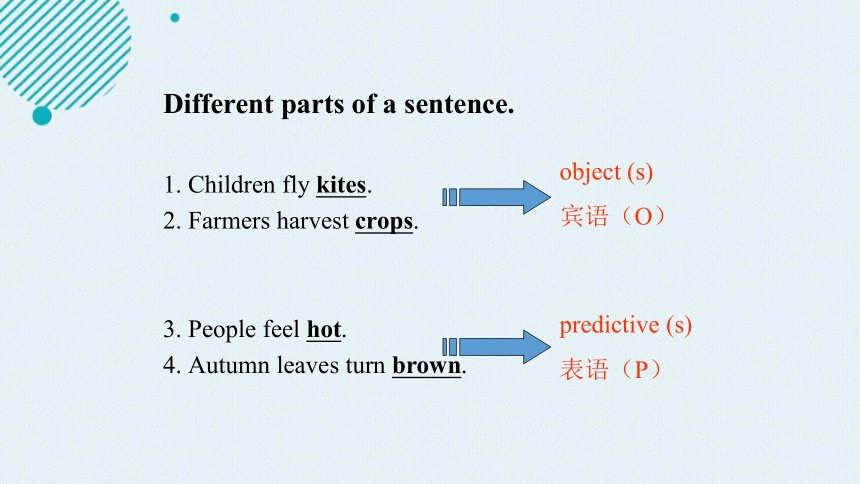
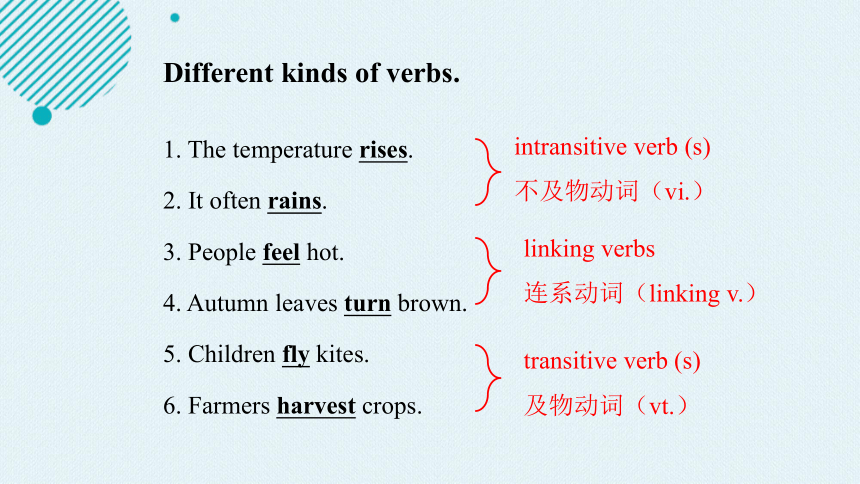
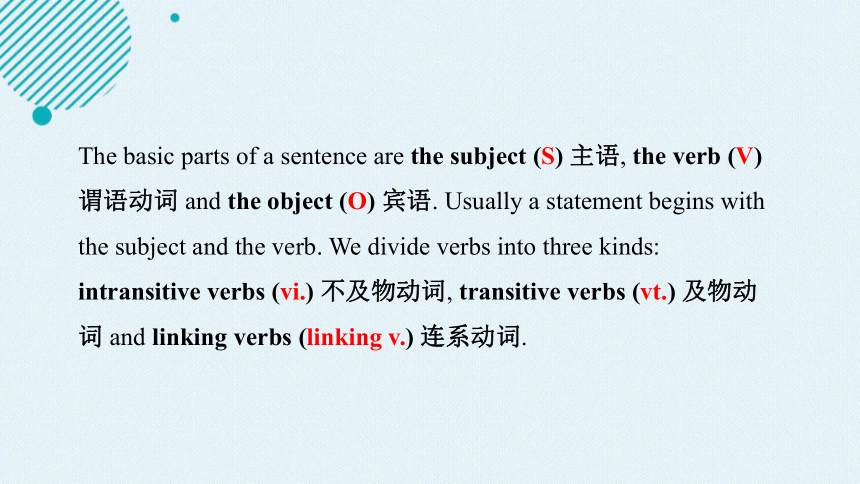

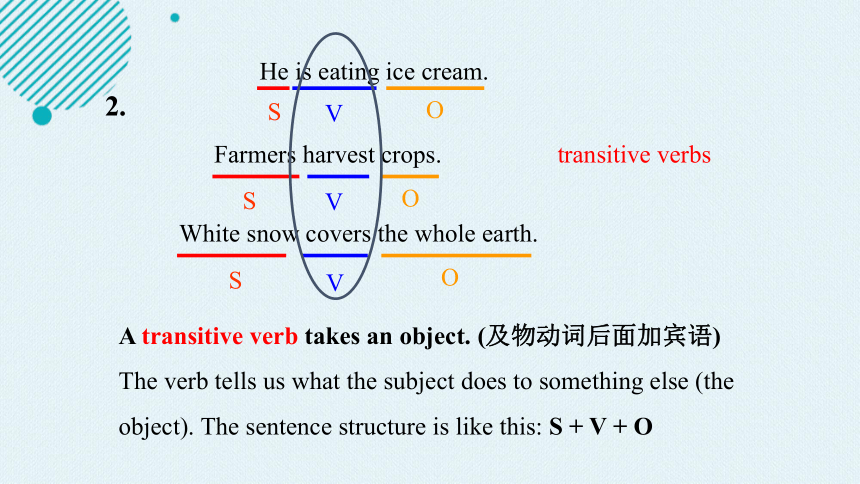
文档简介
(共31张PPT)
Unit 7
Seasons
Period 3
Grammar
1.学习目标
3.重点探究
2.自主学习
学习导航
5.当堂检测
6.课堂总结
4.拓展提升
新课导入
Look and say
1. Time flies.
2. I like autumn.
3. Summer is hot.
4. He brought me cookies.
5. The sun keeps us warm.
1.能熟悉并正确运用本课时的重点单词和短语。
2.能掌握动词及五种基本句型。
学习目标
自主学习
New words
n. 云
vt. 踢
n. 发烧
vi. 咳嗽
adj. 糟糕的,很坏的
cloud
kick
fever
cough
awful
重点探究
1. The temperature rises.
2. It often rains.
3. People feel hot.
4. Autumn leaves turn brown.
5. Children fly kites.
6. Farmers harvest crops.
subject (s)
主语(S)
Know about different parts of a sentence.
1. The temperature rises.
2. It often rains.
3. People feel hot.
4. Autumn leaves turn brown.
5. Children fly kites.
6. Farmers harvest crops.
verb (s)
谓语动词 (V)
Different parts of a sentence.
Different parts of a sentence.
1. Children fly kites.
2. Farmers harvest crops.
3. People feel hot.
4. Autumn leaves turn brown.
object (s)
宾语(O)
predictive (s)
表语(P)
Different kinds of verbs.
1. The temperature rises.
2. It often rains.
3. People feel hot.
4. Autumn leaves turn brown.
5. Children fly kites.
6. Farmers harvest crops.
intransitive verb (s) 不及物动词(vi.)
transitive verb (s) 及物动词(vt.)
linking verbs
连系动词(linking v.)
The basic parts of a sentence are the subject (S) 主语, the verb (V) 谓语动词 and the object (O) 宾语. Usually a statement begins with the subject and the verb. We divide verbs into three kinds: intransitive verbs (vi.) 不及物动词, transitive verbs (vt.) 及物动词 and linking verbs (linking v.) 连系动词.
The leaves fall.
S
V
The temperature drops.
The snowy season will begin.
S
V
S
V
Intransitive verbs
Five kinds of sentence structures.
An intransitive verb does not take an object. (不及物动词后不加宾语) The sentence structure is like this: S + V
1.
He is eating ice cream.
S
V
O
Farmers harvest crops.
S
V
O
White snow covers the whole earth.
S
V
O
transitive verbs
2.
A transitive verb takes an object. (及物动词后面加宾语)
The verb tells us what the subject does to something else (the object). The sentence structure is like this: S + V + O
3.
The flowers are beautiful.
S
V
P
Autumn leaves turn brown.
S
V
P
The weather becomes cool.
S
V
P
linking verbs
A linking verb links the subject and the adjective phrase or noun phrase that describes it.(连系动词连接主语与修饰它的形容词短语或名词短语)
A word or a group of words that follows a linking verb is the predicative (P) (在系动词后面的词或词组叫做表语). The sentence structure is like this: S + V + P
A. Millie is writing about the seasons. Help her underline the verb in each sentence and write down the main structure of the sentence.
1. We have four seasons.
2. They are quite different.
3. Spring is warm and sunny.
4. We fly kites.
___________________
___________________
___________________
___________________
S + V + O
S + V + P
S + V + P
S + V + O
___________________
___________________
___________________
___________________
5. We like summer.
6. Ice cream tastes nice.
7. Autumn arrives.
8. Snow falls.
S + V + O
S + V + P
S + V
S + V
4.
Hobo brought Eddie his clothes.
S
V
IO
DO
Some transitive verbs can take two objects, the direct object (DO)直接宾语 and the indirect object (IO)间接宾语。The sentence structure is like this: S + V + IO + DO
Hobo gave Eddie some ice cream.
Hobo gave some ice cream to Eddie.
We can change the structure S + V + IO + DO with for.
Hobo built Eddie a tent.
Hobo built a tent for Eddie.
We can change the structure S + V + IO + DO with to.
5.
Eddie is watching Hobo work.
S
V
DO
OC
The complement can also follow a direct object to rename or describe it. In this case, it is called the object complement (OC)宾语补足语(补语). The sentence structure is like this: S + V + DO+OC
Hobo built Eddie a tent with sticks at the beach yesterday.
how
where
when
We can add an adverbial to each of the above five main structures. We use an adverbial to show when (adverbial of time), where (adverbial of place) or how (adverbial of manner) an action is done.
B. Amy keeps a weather diary. Read the sentences from her diary entries and describe the main structures of each sentences.
1. It was a perfect day today. There was not a cloud in the sky. Mum was
making breakfast for me when I woke up this morning.
2. The cloud became dark. They covered the sun. Luckily, it didn't rain.
S+V+O
S+V+P
S+V
3. It was New Year's Day. Mum and Dad gave me nice presents, but I was
not happy. The rain was falling from morning till night. I hate rainy days.
4. The sun was shining. I saw some kids kicking the ball in the park. I caught
a bad cold. I had a high fever and coughed a lot, so Mum took me to the
hospital. It was an awful day!
S+V+IO+DO
S+V+P
S+V+O
S+V
S+V+DO+OC
拓展提升
1. I caught a bad cold.
catch a cold 感冒 catch a bad cold 患重感冒
e.g. Put on your jacket, or you'll catch a cold.
穿上你的夹克,不然你会感冒的。
Language Points
2. I had a high fever and coughed a lot, ...
have a fever 发烧 have a high fever 发高烧
e.g. I feel sick. I have a fever.
我感觉不舒服,我发烧了。
动词及五种基本句型
句子的基本组成部分为:主语(S)、动词(V)和宾语(O)。动词可分为行为动词(也称为实义动词)和系动词,在句中可用作谓语。根据这两类动词用作谓语时的不同特点,我们可以把英语句子概括为五种基本句型。
连系动词
连系动词主要是指be动词、感官动词(look、sound、feel、smell、taste)和表示“变,变成”的动词(become、get、grow、turn)。
连系动词本身具有词义,但意义不完整,后需接表语。通
常结构为 S + V + P(主 + 系 + 表)。如:
He is a teacher. 他是个教师。
She looked tired. 她看上去很疲劳。
The story sounds very interesting. 这个故事听起来很有趣。
Her face turned red. 她的脸变红了。
行为动词
行为动词有实在的意义,可在句中独立作谓语,表示动作或状态。行为动词可分为及物动词和不及物动词。
不及物动词本身意义完整,无需带宾语。由这类动词构成
的句子结构为 S + V(主 + 谓)。如:
We all laughed. 我们都笑了。
Peter is swimming in the pool now. 彼得现在正在泳池里游泳。
及物动词本身意义不够完整,后面需接宾语。由这类动词构成
的句子结构为 S + V + O(主 + 谓 + 宾)。如:
His mother cooks dinner every day. 他妈妈每天做饭。
Kitty will watch a film this Sunday. 基蒂这个星期天会去看电影。
有些及物动词后面可以跟两个宾语,其中一个指人,一个指物;
指人的叫间接宾语,指物的叫直接宾语。由这类动词构成的句
子结构是 S + V + IO + DO(主 + 谓 + 间宾 + 直宾)。在这一
结构中,间接宾语常可改成一个由to/for引导的短语:如:
He gave me some food. =He gave some food to me.
他妈妈每天做饭。
I will buy Mum a present. =I will buy a present for Mum.
我要给妈妈买份礼物。
注意:能与to搭配的动词有bring、feed、give、hand、lend、
offer、pass、pay、post、read、sell、send、show、
take、teach、tell、write等。
能与for搭配的动词有bring、build、buy、cook、find、
get、leave、make、order、pick、save等。
有些及物动词后面常跟宾语补足语,用来补充说明宾
语的行为或状态。这样构成的句子结构是 S + V + DO +
OC(主 + 谓 + 直宾 + 宾补)。
I saw him crossing the street.
我看见他在过马路。
当堂检测
一、根据句意及提示完成下列句子。
1. The teacher saw some boys (kick) the football on the playground.
2. What a(n) (极坏的) day! I can't play outside.
3. Her head touched hot. Maybe she got a (发烧).
4. The little dog swallowed (吞) a bone without chewing.
Now he is ________ (咳嗽).
5. Look! There is so much grey (云) gathering. It will rain soon.
kicking
awful
fever
coughing
cloud
_________________
_________________
_________________
_________________
_________________
_________________
_________________
_________________
二、写出下列句子的主要结构。
(S + V)
(S + V + O)
(S + V + DO + OC)
(S + V + P)
(S + V + IO + DO)
(S + V + O)
(S + V + DO + OC)
(S + V + DO + OC)
1. She laughed.
2. He bought a T-shirt.
3. Jay named his dog Bobby.
4. She looks lovely.
5. He gave Mary a present.
6. The teacher is marking the tests.
7. They thought John the best actor.
8. I find the article interesting.
课堂总结
重点单词和短语:
cloud, kick, fever, cough, awful, have a cold, have a fever
动词及五种基本句型:
1. 动词可分为___________(__________)和__________,前一类动词可以分为___________和____________。
2. 五种基本句型包括
a. _______________________________
b. _______________________________
c. _______________________________
d._______________________________
e._______________________________
Unit 7
Period 3
行为动词
实义动词
系动词
及物动词
不及物动词
主+谓 (S+V)
主+谓+宾 (S+V+O)
主+系+表 (S+V+P)
主+谓+间宾+直宾 (S+V+IO+DO)
主+谓+直宾+宾补 (S+V+DO+OC)
Unit 7
Seasons
Period 3
Grammar
1.学习目标
3.重点探究
2.自主学习
学习导航
5.当堂检测
6.课堂总结
4.拓展提升
新课导入
Look and say
1. Time flies.
2. I like autumn.
3. Summer is hot.
4. He brought me cookies.
5. The sun keeps us warm.
1.能熟悉并正确运用本课时的重点单词和短语。
2.能掌握动词及五种基本句型。
学习目标
自主学习
New words
n. 云
vt. 踢
n. 发烧
vi. 咳嗽
adj. 糟糕的,很坏的
cloud
kick
fever
cough
awful
重点探究
1. The temperature rises.
2. It often rains.
3. People feel hot.
4. Autumn leaves turn brown.
5. Children fly kites.
6. Farmers harvest crops.
subject (s)
主语(S)
Know about different parts of a sentence.
1. The temperature rises.
2. It often rains.
3. People feel hot.
4. Autumn leaves turn brown.
5. Children fly kites.
6. Farmers harvest crops.
verb (s)
谓语动词 (V)
Different parts of a sentence.
Different parts of a sentence.
1. Children fly kites.
2. Farmers harvest crops.
3. People feel hot.
4. Autumn leaves turn brown.
object (s)
宾语(O)
predictive (s)
表语(P)
Different kinds of verbs.
1. The temperature rises.
2. It often rains.
3. People feel hot.
4. Autumn leaves turn brown.
5. Children fly kites.
6. Farmers harvest crops.
intransitive verb (s) 不及物动词(vi.)
transitive verb (s) 及物动词(vt.)
linking verbs
连系动词(linking v.)
The basic parts of a sentence are the subject (S) 主语, the verb (V) 谓语动词 and the object (O) 宾语. Usually a statement begins with the subject and the verb. We divide verbs into three kinds: intransitive verbs (vi.) 不及物动词, transitive verbs (vt.) 及物动词 and linking verbs (linking v.) 连系动词.
The leaves fall.
S
V
The temperature drops.
The snowy season will begin.
S
V
S
V
Intransitive verbs
Five kinds of sentence structures.
An intransitive verb does not take an object. (不及物动词后不加宾语) The sentence structure is like this: S + V
1.
He is eating ice cream.
S
V
O
Farmers harvest crops.
S
V
O
White snow covers the whole earth.
S
V
O
transitive verbs
2.
A transitive verb takes an object. (及物动词后面加宾语)
The verb tells us what the subject does to something else (the object). The sentence structure is like this: S + V + O
3.
The flowers are beautiful.
S
V
P
Autumn leaves turn brown.
S
V
P
The weather becomes cool.
S
V
P
linking verbs
A linking verb links the subject and the adjective phrase or noun phrase that describes it.(连系动词连接主语与修饰它的形容词短语或名词短语)
A word or a group of words that follows a linking verb is the predicative (P) (在系动词后面的词或词组叫做表语). The sentence structure is like this: S + V + P
A. Millie is writing about the seasons. Help her underline the verb in each sentence and write down the main structure of the sentence.
1. We have four seasons.
2. They are quite different.
3. Spring is warm and sunny.
4. We fly kites.
___________________
___________________
___________________
___________________
S + V + O
S + V + P
S + V + P
S + V + O
___________________
___________________
___________________
___________________
5. We like summer.
6. Ice cream tastes nice.
7. Autumn arrives.
8. Snow falls.
S + V + O
S + V + P
S + V
S + V
4.
Hobo brought Eddie his clothes.
S
V
IO
DO
Some transitive verbs can take two objects, the direct object (DO)直接宾语 and the indirect object (IO)间接宾语。The sentence structure is like this: S + V + IO + DO
Hobo gave Eddie some ice cream.
Hobo gave some ice cream to Eddie.
We can change the structure S + V + IO + DO with for.
Hobo built Eddie a tent.
Hobo built a tent for Eddie.
We can change the structure S + V + IO + DO with to.
5.
Eddie is watching Hobo work.
S
V
DO
OC
The complement can also follow a direct object to rename or describe it. In this case, it is called the object complement (OC)宾语补足语(补语). The sentence structure is like this: S + V + DO+OC
Hobo built Eddie a tent with sticks at the beach yesterday.
how
where
when
We can add an adverbial to each of the above five main structures. We use an adverbial to show when (adverbial of time), where (adverbial of place) or how (adverbial of manner) an action is done.
B. Amy keeps a weather diary. Read the sentences from her diary entries and describe the main structures of each sentences.
1. It was a perfect day today. There was not a cloud in the sky. Mum was
making breakfast for me when I woke up this morning.
2. The cloud became dark. They covered the sun. Luckily, it didn't rain.
S+V+O
S+V+P
S+V
3. It was New Year's Day. Mum and Dad gave me nice presents, but I was
not happy. The rain was falling from morning till night. I hate rainy days.
4. The sun was shining. I saw some kids kicking the ball in the park. I caught
a bad cold. I had a high fever and coughed a lot, so Mum took me to the
hospital. It was an awful day!
S+V+IO+DO
S+V+P
S+V+O
S+V
S+V+DO+OC
拓展提升
1. I caught a bad cold.
catch a cold 感冒 catch a bad cold 患重感冒
e.g. Put on your jacket, or you'll catch a cold.
穿上你的夹克,不然你会感冒的。
Language Points
2. I had a high fever and coughed a lot, ...
have a fever 发烧 have a high fever 发高烧
e.g. I feel sick. I have a fever.
我感觉不舒服,我发烧了。
动词及五种基本句型
句子的基本组成部分为:主语(S)、动词(V)和宾语(O)。动词可分为行为动词(也称为实义动词)和系动词,在句中可用作谓语。根据这两类动词用作谓语时的不同特点,我们可以把英语句子概括为五种基本句型。
连系动词
连系动词主要是指be动词、感官动词(look、sound、feel、smell、taste)和表示“变,变成”的动词(become、get、grow、turn)。
连系动词本身具有词义,但意义不完整,后需接表语。通
常结构为 S + V + P(主 + 系 + 表)。如:
He is a teacher. 他是个教师。
She looked tired. 她看上去很疲劳。
The story sounds very interesting. 这个故事听起来很有趣。
Her face turned red. 她的脸变红了。
行为动词
行为动词有实在的意义,可在句中独立作谓语,表示动作或状态。行为动词可分为及物动词和不及物动词。
不及物动词本身意义完整,无需带宾语。由这类动词构成
的句子结构为 S + V(主 + 谓)。如:
We all laughed. 我们都笑了。
Peter is swimming in the pool now. 彼得现在正在泳池里游泳。
及物动词本身意义不够完整,后面需接宾语。由这类动词构成
的句子结构为 S + V + O(主 + 谓 + 宾)。如:
His mother cooks dinner every day. 他妈妈每天做饭。
Kitty will watch a film this Sunday. 基蒂这个星期天会去看电影。
有些及物动词后面可以跟两个宾语,其中一个指人,一个指物;
指人的叫间接宾语,指物的叫直接宾语。由这类动词构成的句
子结构是 S + V + IO + DO(主 + 谓 + 间宾 + 直宾)。在这一
结构中,间接宾语常可改成一个由to/for引导的短语:如:
He gave me some food. =He gave some food to me.
他妈妈每天做饭。
I will buy Mum a present. =I will buy a present for Mum.
我要给妈妈买份礼物。
注意:能与to搭配的动词有bring、feed、give、hand、lend、
offer、pass、pay、post、read、sell、send、show、
take、teach、tell、write等。
能与for搭配的动词有bring、build、buy、cook、find、
get、leave、make、order、pick、save等。
有些及物动词后面常跟宾语补足语,用来补充说明宾
语的行为或状态。这样构成的句子结构是 S + V + DO +
OC(主 + 谓 + 直宾 + 宾补)。
I saw him crossing the street.
我看见他在过马路。
当堂检测
一、根据句意及提示完成下列句子。
1. The teacher saw some boys (kick) the football on the playground.
2. What a(n) (极坏的) day! I can't play outside.
3. Her head touched hot. Maybe she got a (发烧).
4. The little dog swallowed (吞) a bone without chewing.
Now he is ________ (咳嗽).
5. Look! There is so much grey (云) gathering. It will rain soon.
kicking
awful
fever
coughing
cloud
_________________
_________________
_________________
_________________
_________________
_________________
_________________
_________________
二、写出下列句子的主要结构。
(S + V)
(S + V + O)
(S + V + DO + OC)
(S + V + P)
(S + V + IO + DO)
(S + V + O)
(S + V + DO + OC)
(S + V + DO + OC)
1. She laughed.
2. He bought a T-shirt.
3. Jay named his dog Bobby.
4. She looks lovely.
5. He gave Mary a present.
6. The teacher is marking the tests.
7. They thought John the best actor.
8. I find the article interesting.
课堂总结
重点单词和短语:
cloud, kick, fever, cough, awful, have a cold, have a fever
动词及五种基本句型:
1. 动词可分为___________(__________)和__________,前一类动词可以分为___________和____________。
2. 五种基本句型包括
a. _______________________________
b. _______________________________
c. _______________________________
d._______________________________
e._______________________________
Unit 7
Period 3
行为动词
实义动词
系动词
及物动词
不及物动词
主+谓 (S+V)
主+谓+宾 (S+V+O)
主+系+表 (S+V+P)
主+谓+间宾+直宾 (S+V+IO+DO)
主+谓+直宾+宾补 (S+V+DO+OC)
